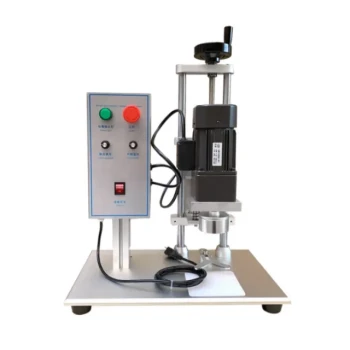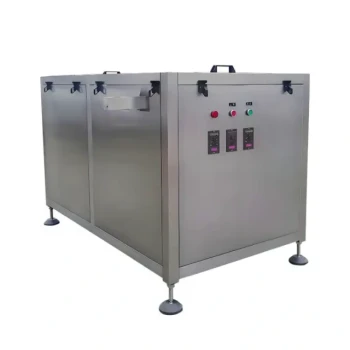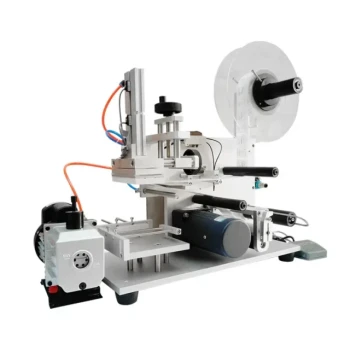At their core, capping machines are categorized by their level of automation. The primary types are manual, semi-automatic, and fully automatic, each designed to meet vastly different production scales. These machines can be further specialized to handle specific cap styles, such as screw caps, press-on caps, or corks.
The decision is not about finding the "best" capping machine, but about selecting the right tool for the job. Your choice must align directly with your production volume, budget, and operational complexity.
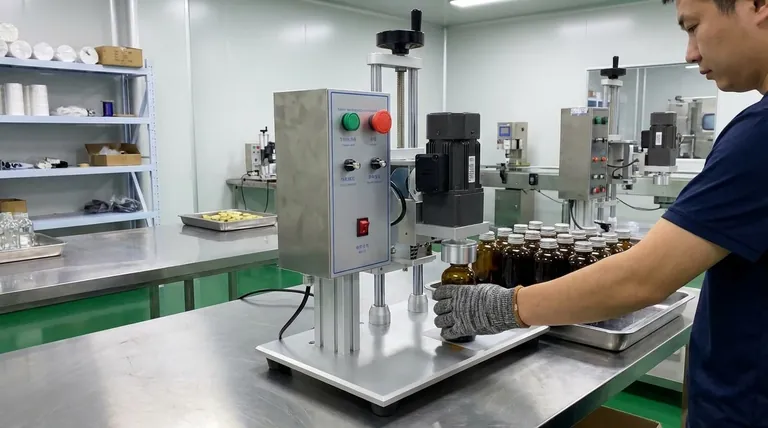
The Core Categories of Capping Machines
Understanding the three levels of automation is the first step in determining which machine architecture fits your operational needs.
Manual Capping Machines
These are the most basic and least expensive capping solutions, often handheld or mounted on a simple benchtop stand. The operator is responsible for nearly every step: placing the cap on the container, positioning the container under the capper, and activating the machine.
Manual cappers are best suited for hobbyists, lab environments for testing, or very small-scale businesses just starting out. Their primary advantage is the extremely low initial cost.
Semi-Automatic Capping Machines
This category represents a significant step up in efficiency and consistency. The operator typically places the cap on the container and positions it in the machine, which then automatically performs the tightening or sealing process.
Semi-automatic machines offer a balance between investment and output. They are the workhorses for many small to medium-sized businesses that have outgrown manual processes but are not yet ready for a fully automated line.
Fully Automatic Capping Machines
These are high-speed, integrated systems that require minimal operator intervention. They automatically handle everything from sorting and feeding caps to placing and tightening them on containers moving along a conveyor.
Fully automatic cappers are a necessity for large-scale manufacturing and high-volume production lines. They offer the highest throughput and lowest per-unit labor cost, but demand a significant capital investment and more complex maintenance.
Understanding the Trade-offs
Choosing a capping machine involves a clear set of compromises. Being aware of them is critical for making a sound investment.
Cost vs. Throughput
This is the most fundamental trade-off. A manual capper may cost a few hundred dollars but can only produce a few units per minute. A fully automatic system can cost tens or even hundreds of thousands of dollars but can cap hundreds of units per minute.
Flexibility vs. Specialization
Manual and some semi-automatic machines are often highly flexible, able to handle different container and cap sizes with minimal adjustment.
Fully automatic machines are typically optimized for a specific container and cap. Changing to a different format often requires expensive and time-consuming "change parts" and skilled technical adjustments.
Operator Involvement vs. Technical Skill
Lower levels of automation require more direct labor to operate but are mechanically simple and easy to maintain.
Fully automatic systems reduce the need for operators but demand a higher level of technical skill for setup, integration, and troubleshooting.
Making the Right Choice for Your Operation
Select your machine based on a realistic assessment of your current and near-future production goals.
- If your primary focus is low-volume production or product development: A manual capper provides the necessary function with the lowest possible initial investment.
- If your primary focus is scaling a growing business: A semi-automatic machine delivers the most significant return on investment by boosting speed and consistency.
- If your primary focus is maximizing output in a large-scale facility: A fully automatic system is the only solution that can meet high-volume demand while minimizing long-term labor costs.
Ultimately, the right capping machine is a strategic asset that directly supports your business's growth trajectory.
Summary Table:
| Automation Level | Best For | Key Advantage | Key Trade-off |
|---|---|---|---|
| Manual | Hobbyists, labs, small startups | Lowest initial cost | Very low throughput, high labor |
| Semi-Automatic | Small to medium businesses | Balance of cost and efficiency | Moderate operator involvement |
| Fully Automatic | Large-scale, high-volume production | Highest throughput, lowest labor cost | High capital investment, less flexible |
Ready to Scale Your Capping Operations?
Choosing the right capping machine is a critical decision for your business's efficiency and growth. HONESTBEE supplies robust beekeeping supplies and equipment, including solutions for commercial apiaries and distributors.
Let our experts help you select the perfect capping equipment to maximize your productivity and ROI.
Contact HONESTBEE today for a personalized consultation and discover how our wholesale-focused operations can benefit your business!
Visual Guide
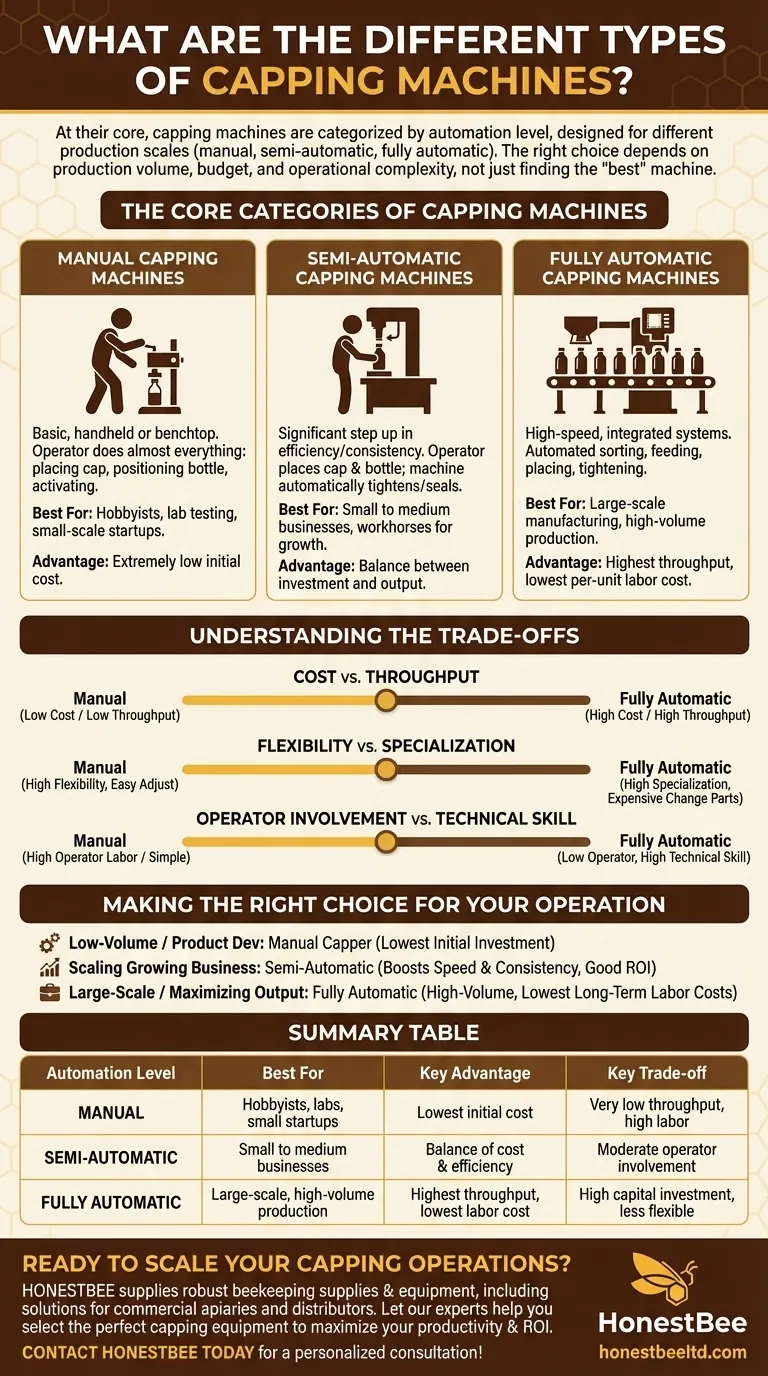
Related Products
- Semi Automatic Electric Bottle Capping Machine
- HONESTBEE Professional Benchtop Pneumatic Bottle Capping Machine Capper
- Semi Automatic Round Bottle Labeling Machine
- Automated Rotary Bottle Unscrambler for Honey Production Line
- Fully Automatic High Speed Centrifugal Bottle Unscrambler
People Also Ask
- What is the purpose of a bottle capping machine? Boost Efficiency and Ensure Product Integrity
- What are the categories of bottle capping machines? Choose the Right Automation for Your Line
- How do bottle seals work? Unlock the Technology Behind Product Integrity
- What type of machine is recommended for smaller businesses? The Smart Choice for Growing Operations
- Which machine is used for sealing of bottles? Choose the Right Capper for Your Production Line
